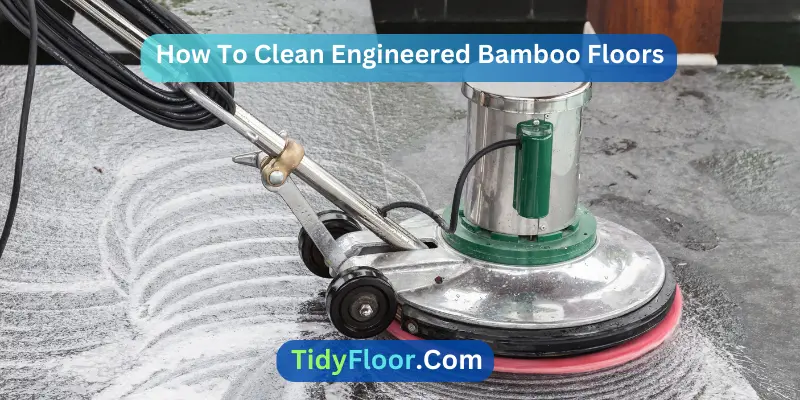Engineered bamboo flooring has gained popularity for its sustainability, durability, and aesthetic appeal. As a homeowner, it’s essential to know how to clean engineered bamboo floors to ensure they remain in pristine condition for years to come.
To maintain your engineered bamboo floors, start by gathering cleaning supplies. Sweep away dust and debris, then mop with a pH-balanced solution. Address stains gently and rinse. Dry thoroughly and optionally apply a bamboo floor conditioner for that extra shine on the flooring.
In this guide, we will walk you through a step-by-step process to effectively clean and care for your bamboo-engineered flooring, helping you preserve its natural beauty and extend its lifespan.
7 Step-by-Step Process to Clean Engineered Bamboo Floors: For Best Result
Be it Cali-engineered bamboo flooring or bamboo-engineered hardwood flooring, maintenance and proper cleaning are mandatory to keep up the shine and enhance its durability. Here is how you can plan your cleaning.
Step 1: Remove Dust and Debris
Start by using a soft-bristle broom to gently sweep away any dust, dirt, or debris from the surface of the engineered bamboo floors. This initial step prevents particles from scratching the floor’s finish during the cleaning process.
Step 2: Prepare the Cleaning Solution
Fill a bucket with warm water and add a small amount of pH-balanced bamboo floor cleaner according to the manufacturer’s instructions. Be sure to choose a cleaner specifically designed for bamboo floors to avoid any potential damage.
Step 3: Mop the Floors
Dampen a microfiber mop in the prepared cleaning solution, making sure it’s not overly wet. Excess water can seep into the seams and cause swelling or warping of the bamboo. Gently mop the floor, following the grain of the bamboo, to remove dirt and grime. Remember to wring out the mop thoroughly before each pass.
Step 4: Address Stubborn Stains
For stubborn stains or spills, dampen a clean, lint-free cloth with the cleaning solution and gently blot the affected area. Avoid rubbing vigorously, as this can damage the bamboo’s surface. If the stain persists, you can try using a specialized bamboo floor stain remover, following the manufacturer’s instructions.
Step 5: Rinse the Floors
Once you’ve finished mopping and spot-cleaning, it’s crucial to remove any remaining cleaning solution from the floor. Fill a clean bucket with plain, warm water and dampen a fresh microfiber mop. Go over the entire floor again to rinse off any residual cleaner.
Step 6: Dry the Floors
After rinsing, use clean, dry lint-free cloths to dry the surface of the engineered bamboo floors. Ensure that no moisture is left behind, as excessive water can cause the bamboo to warp or swell.
Step 7: Apply a Bamboo Floor Conditioner (Optional)
If desired, you can apply a specialized bamboo floor conditioner to enhance the luster and protect the finish of your engineered bamboo floors. Follow the manufacturer’s instructions for application and drying times.
10 Tips About the Best Way to Clean Engineered Bamboo Floors
Cleaning engineered bamboo floors requires a delicate balance between maintaining their natural beauty and ensuring their longevity. Follow these essential tips to ensure that you’re cleaning your engineered bamboo floors effectively and preserving their stunning appearance.
- Use the Right Cleaning Products:
Opt for pH-balanced bamboo floor cleaners specifically designed for engineered bamboo. Regular household cleaners might contain abrasive chemicals that can harm the bamboo’s finish or lead to discoloration over time.
- Regular Sweeping or Dust Mopping:
Dust and debris can accumulate quickly, causing small scratches. Make it a habit to sweep or dust mop your floors daily to prevent particles from accumulating and damaging the surface.
- Damp Mopping Technique:
When it’s time for a more thorough clean, use a damp mop with a carefully measured amount of the recommended bamboo floor cleaner. The mop should be damp, not soaking wet, as excess moisture can cause warping or swelling of the bamboo.
- Spot Cleaning for Stains:
For spills or stains, address them promptly with a soft, lint-free cloth dampened with the cleaning solution. Avoid rubbing vigorously, which could damage the bamboo. If the stain persists, consider using a specialized bamboo floor stain remover.
- Rinse and Dry Thoroughly:
After mopping, rinse the floors with clean water using a fresh microfiber mop to remove any residual cleaner. Dry the floors thoroughly with clean, lint-free cloths to prevent water damage.
- Protect from Furniture and Pets:
Use felt pads under furniture legs to prevent scratches, and place rugs or mats in high-traffic areas. Trim pets’ nails regularly to avoid floor damage, and promptly clean up any accidents.
- Avoid Steam Cleaners and Harsh Chemicals:
Steam cleaners can introduce excess moisture, causing potential damage. Harsh chemicals can strip the bamboo’s finish and impact its appearance. Stick to gentle, bamboo-specific cleaning solutions.
- Preventive Measures:
Use doormats at entrances to trap dirt and moisture. Encourage family members and guests to remove their shoes, reducing the risk of tracking debris onto the floors.
- Bamboo Floor Conditioner (Optional):
If desired, apply a specialized bamboo floor conditioner after cleaning to enhance the floor’s natural luster and provide additional protection. Follow the manufacturer’s instructions for proper application.
- Regular Maintenance:
Consistency is key. Implement a regular cleaning schedule and stick to it. By maintaining a clean and debris-free surface, you can avoid the need for more aggressive cleaning methods in the future.
10 Mistakes to Avoid When Installing Engineered Bamboo Flooring on Concrete
Installing engineered bamboo flooring on concrete can transform your space with natural beauty and durability. However, the process requires careful attention to detail to ensure a successful and long-lasting installation. Be it engineered bamboo click flooring or glued, here are key mistakes to steer clear of when embarking on this project.
- Skipping Moisture Testing:
Concrete slabs can emit moisture that can damage bamboo flooring over time. Failing to conduct proper moisture testing before installation can lead to warping, buckling, and other issues. Use a reliable moisture meter to assess the concrete’s moisture content and ensure it falls within the manufacturer’s recommended range.
- Neglecting Moisture Barriers:
Even if moisture levels are acceptable, it’s crucial to incorporate a moisture barrier to prevent any potential moisture migration from the concrete. Installing an appropriate vapor barrier, such as a plastic sheet or moisture-resistant underlayment, acts as a safeguard against future moisture-related problems.
- Inadequate Subfloor Preparation:
Proper subfloor preparation is paramount. Concrete surfaces should be level, smooth, and clean. Remove any debris, dirt, or adhesive residues that could compromise the installation’s integrity. Use a self-leveling compound if necessary to achieve an even surface.
- Improper Acclimation:
Engineered bamboo flooring needs to acclimate to the installation environment before being laid down. Failing to allow sufficient time for acclimation can lead to gapping or buckling later on. Follow the manufacturer’s guidelines for acclimation duration, typically a few days to a week, with the boxes opened in the installation area.
- Ignoring Expansion Gaps:
Bamboo, like any wood, expands and contracts with changes in humidity and temperature. Neglecting to leave adequate expansion gaps around the perimeter of the room and fixed objects can result in unsightly buckling or warping. Use spacers to maintain consistent gaps.
- Incorrect Adhesive Application:
If you’re using adhesive to attach the bamboo flooring to the concrete, applying it improperly can cause problems. Either using too much adhesive or too little can result in a compromised bond. Follow the adhesive manufacturer’s guidelines meticulously for correct application.
- Rushing the Installation:
Installing bamboo flooring is a meticulous process that requires patience and precision. Rushing through the installation can lead to misaligned planks, uneven spacing, and an overall subpar finish. Take the time to measure, cut, and lay each piece with care.
- Disregarding Manufacturer Instructions:
Every engineered bamboo flooring product may have specific installation instructions provided by the manufacturer. Ignoring these instructions can void warranties and lead to unsatisfactory outcomes. Always follow the guidelines for the specific product you’re using.
- Neglecting Professional Help:
If you’re uncertain about any aspect of the installation, seeking professional assistance is wise. From moisture testing to subfloor preparation, professionals can ensure that every step is executed correctly, saving you time, money, and potential headaches.
- Forgetting About Finishing:
After the bamboo flooring is installed, applying a protective finish is essential. Whether it’s a polyurethane coating or another suitable finish, this step provides durability, and protection, and enhances the bamboo’s natural beauty.
FAQs:
Can I Use Regular Cleaning Products On Engineered Bamboo Floors?
It’s recommended to use pH-balanced bamboo floor cleaners. Regular products may contain harsh chemicals that can damage the bamboo’s finish or cause discoloration over time.
How Often Should I Clean My Engineered Bamboo Floors?
Sweep or dust mop daily to prevent debris buildup. A full cleaning using a damp mop should be done weekly or as needed to maintain their appearance.
Can I Use A Steam Cleaner On Bamboo Floors?
No, steam cleaners can introduce excess moisture, potentially leading to warping or swelling. Stick to damp mopping with minimal water.
What Should I Do If Water Spills On The Bamboo Engineered Floor?
Quickly blot the spill with a clean cloth to prevent moisture from seeping into the bamboo. Avoid leaving standing water, as it can damage the flooring.
How Do I Remove Scuff Marks Without Damaging The Floor?
Gently rub scuff marks with a soft cloth dampened with water. If that doesn’t work, try using a small amount of the pH-balanced bamboo floor cleaner on a cloth.
Can I Use Vinegar To Clean Bamboo Floors?
It’s best to avoid using vinegar, as its acidic nature could potentially harm the bamboo’s finish or cause dullness over time.
Is It Necessary To Dry The Floors After Cleaning?
Yes, excess moisture can lead to damage. Ensure the floors are completely dry after mopping by using clean, dry cloths to prevent warping or swelling.
How Can I Prevent Scratches On My Bamboo Floors?
Place felt pads under furniture legs and use rugs or mats in high-traffic areas to minimize the risk of scratches from dirt and debris.
Can I Use A Vacuum Cleaner On Bamboo Floors?
Yes, but use a vacuum with a soft brush attachment to prevent scratching. Avoid vacuum cleaners with beater bars, as they can damage the flooring.
Are There Any Special Considerations Homes For Bamboo Floors With Pets?
Trim your pets’ nails regularly to prevent scratches. Clean up accidents promptly and avoid using harsh chemicals, as they can harm the bamboo’s finish.
Conclusion:
Now you know how to clean engineered bamboo floors and maintain their elegance and charm. By following this step-by-step cleaning guide, you can effectively remove dirt, stains, and debris from your floors while preserving their natural beauty and longevity.
Regular cleaning and gentle care will ensure that your engineered bamboo floors continue to shine for years to come, creating a welcoming and aesthetically pleasing environment in your living space.


